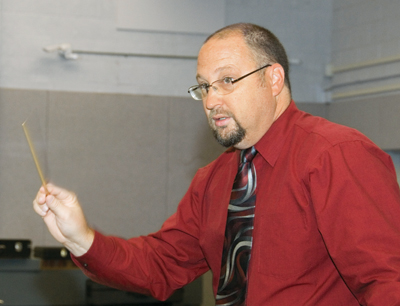
I am frequently called to judge concert band contests and festivals, and I have noticed over the years that the same details are often neglected by many of the ensembles I evaluate. Having been a high school band director, I understand the enormity of the tasks that come with the job, such as attendance, fundraising, and administration. It is easy to get caught up in the minutiae and the managerial duties and overlook the small details that make a good performance and impress judges.
Appearance
I may be old fashioned, but I like to see bands dressed the same. They don’t have to wear band uniforms, but uniformity is important, especially for state music festivals. Directors should make sure that students are dressed appropriately – no white socks with black uniforms, no untied shoes, no sandals.
The order in which students come on stage can make a good impression as well. I like to see a band enter in single file and remain standing until everyone is on stage and has a chair and stand. It says something about the level of coordination and attention to detail before they ever play a note.
Sound Quality
All bands should spend time listening to excellent ensembles so they know the standard they are trying to reach. Even for outstanding school bands, hearing themselves every day is not the same as hearing the Dallas Wind Symphony or the Tokyo Kosei. Only after students know what to work for can they begin working toward it. Sound development includes teaching good breath support, playing chorales in warm-ups, and training students to listen to each other. Warm-ups should be a musical experience rather than just technical. If we teach a good sound concept during the warm-up process, and have a routine tuning process, these musical elements will transfer to the music we are playing in performance.
If an ensemble lacks low reeds or tubas, I encourage directors to add these voices. Without those voices, it is impossible to get a good band sound. With some creative rewriting and careful attention to balance, directors can still tone down upper woodwinds and brass to the point that alto, tenor, and bass voices can be heard. Bands tend to be top-heavy, but many directors don’t make the effort to overcome those things, taking an attitude of “This is what we have, so we’re going to go with it.” Instead of that, find a way to overcome the problem.
Saxophonists playing too loudly is one of the most common balance problems. This is often because there are too many saxes. The best solution is to ask the saxophonists to adjust their dynamics: if the part says forte but there are six altos, they should mark the dynamic down to at least mezzo-forte. Directors should take time to make these adjustments to dynamic levels to bring things into context, which depends on the instrumentation.
Substitutions
I don’t need to see notes in the score when parts have been rewritten. Such substitutions as saxophones playing horn parts, euphoniums playing bassoon parts, and baritone saxes playing tuba parts are common, and if I hear a tuba part but don’t see a tuba player I can figure it out. For something more unusual, such as a trumpet player covering a second alto sax part, a note would be appreciated.
It is unwise to write a note in the front of the score explaining why the band may not sound good. Directors may write that it is a 7th-12th grade band that is 60% 7th graders and meets on a block schedule, and that is a difficult situation, but if you pick appropriate music the band can still sound good.
Percussion
Timpanists should use a tuning fork or a pitch pipe. If these are unavailable, a mallet instrument is a good choice, although students invariably choose bells. Instead, they should use a marimba so the pitch sounds in the correct octave. I find it distracting for a trombone player to stand up and play a note for the timpanist to tune to.
Other things to watch for include making certain that students play with a true bass drum mallet that is in good shape, use an actual triangle beater rather than random things found in the percussion cabinet, such as a snare drum lug, and use appropriate mallets. Yarn mallets might work best with a chorale, but a louder section may best be played with acrylic mallets. It boils down to making conscious choices rather than letting students arbitrarily choose mallets.
Too often bands leave auxiliary percussion parts out instead of coming up with appropriate substitutions for missing instruments. Use a triangle instead of finger cymbals or bells instead of crotales. This is especially frustrating if there are percussionists who are not playing on that piece. If there is an available student and a substitution can be made for a missing instrument, the part should be covered.
These small details send a message that there wasn’t enough depth of thought while preparing the ensemble. Students have learned notes and rhythms, but haven’t delved into playing musically; they’re only concerned with the managerial aspects. Tuning the timpani with a trombone or using a snare stand that is too low leaves a bad first impression on a judge.
Articulations
I hear too many ambiguous articulations because students ignore accents and staccatos, and when they do play staccato either only some of the band plays staccato or the note lengths are unequal. Similarly, the important part of slow legato music is what happens between the notes. If students understand how to move and keep the direction going from one note to the next, they’ve got the legato style down. Rather than worrying about the beginning of the note, students should know how it moves to the next note.
I use different types of balls to teach articulation. Think about ping-pong balls for staccato, softballs for a normal articulation, and bowling balls for marcato. Legato is like keeping a feather afloat: the motion of the feather never stops and just a little breath of air keeps it floating and moving from side to side. For tenuto, I use those giant inflatable rubber balls with the handle that children can ride on. The note leans down and then rebounds back up. I’ll say, “Let’s play four softballs or four ping pong balls or four feathers.” Students easily grasp the difference in those sounds when they can put a visual representation with them.
Dynamics
For dynamics, I teach the difference between miles per hour, meaning air speed, and gallons, meaning quantity of air. If playing forte means moving ten gallons of air 70 miles per hour, then piano should be two gallons of air at 70 miles per hour. The quantity of air may change, but the speed of air cannot. Students run into problems when they decrease both the speed and the quantity of air because the sound is no longer supported. I’ve had good luck with this analogy getting students to continue pushing air through their instruments, but with a smaller airstream.
When flute and brass players play softly and don’t keep the airflow going, they go flat, but clarinets tend to pinch sharp. The pitch of dynamic changes is incredibly important. I recommend playing exercises where the goal is to maintain a consistent pitch through different dynamic levels. When a band is playing fast and loud, there is a certain sound that is produced, but as soon as the tempo and dynamics slow down, there is often a completely different sound because of a lack of breath support.
Most Common Comment
The thing I ask for most often is more shape to the line. Students can play the right notes and rhythms without communicating anything. I want to hear contour, emotion, and energy. Move on from notes and rhythms to dynamics, blend, and phrasing. That’s what creates life in music. It’s easy to get bogged down working on technique and ensemble precision.





